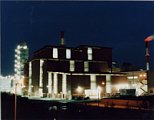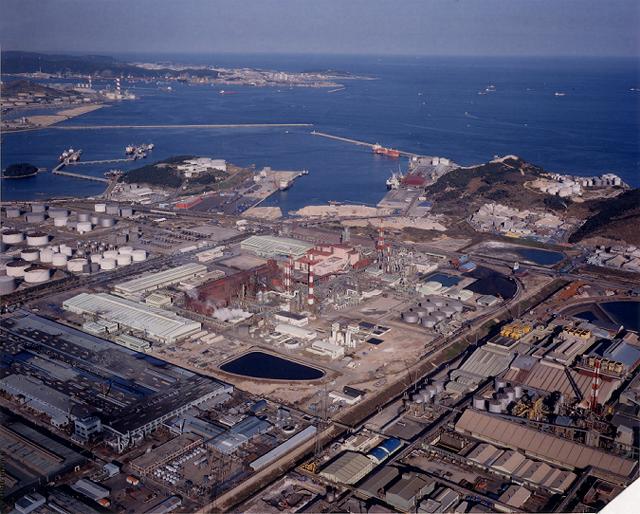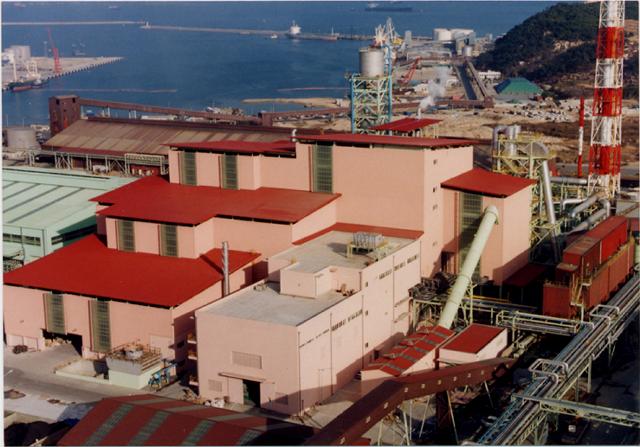
Night View of Onsan's Miitsubishi Process Smelter Building |
LG-Nikko Copper Inc. (previously LG Metals Corporation) has operated an Outokumpu flash smelting furnace line with three P.S. converters at their Onsan Smelter since 1979, capable of producing 140,000 tons of copper from concentrate. In the early 1990's then LG Metals Corporation (LGMC) undertook a study to explore the possibility of increasing production to meet the steady increase in demand for copper in Korea. Initially, LGMC considered the installing another smelting furnace and making with full use of existing facilities but abandoned it due to economics, coupled with the expected heavy capital expenditure required to meet more stringent environmental regulations in the future. |
In light of these facts, they decided to
establish a new separate smelting line with
larger capacity, and after reviewing several
processes based on capital expenditure, easiness
of operation, compatibility with the existing
smelter line, environmental compliance, and
in-plant hygiene, the MITSUBISHI PROCESS
was selected for the following reasons:
EDirect capital cost savings
EEnvironmental considerations
EAppropriate layout in available space
EProven technology at the time of selection
Even though P.S. converters are versatile and proven, they were not considered for the expansion, due to technical problems associated with effective capture of fugitive gases.
Mitsubishi Materials Corporation licensed LGMC with the Mitsubishi Process, and provided basic engineering, technical assistance, and training services, as well as proprietary equipment.
LGMC's sister company LG Engineering Co. then proceeded to conduct detail engineering, and LG Construction Co. headed construction of the plant.
While construction was ongoing, operators were recruited and trained. About a half of the required personnel for the new Mitsubishi line were transferred from the existing flash smelting line, and sent to Mitsubishi Materials' Naoshima Smelter for a month to receive training. After returning, they were assigned with the task of overlooking installation of major equipment and becoming familiar with the new facilities. The remaining half of operators were newly recruited and trained by experienced operators until the start-up.
Feeding was commenced on January 31, 1998, and after sorting out initial teething problems which were mostly overcome within the first two months, a Performance Guarantee Test for the smelter was successfully completed on March 25, 1998. As operations further continued to improve and stabilize, on-line availability reached 95% in 1999, higher than the design figure of 92%.
The tables below show the major design and operating parameters for Onsan's Mitsubishi Process line, as well as current typical operating data.
Finally it is noteworthy that although the original smelter design capacity was 160,000 mtpy from concentrate in 1999, it surpassed 210,000 mtpy in 1999, and was further increased to over 260,000 mtpy from concentrate in 2002, using the same furnace dimensions.
The table below shows a comparison between original design and current typical operating parameters of Onsan's Mitsubishi Process Smelter.
| Design | Current | ||
| S Furnace Concentrates Coal Return C-slag Scrap |
T/H T/H T/H T/H |
74.9 1.9 8.4 - |
103.2 1.4 9.3 - |
|
Nm3/H Nm3/H Nm3/H % |
22,000 12,700 34,700 50.0 |
18,600 16,500 35,100 57.7 |
|
C Furnace Matte Anode scrap Return C-slag Scrap |
T/H T/H T/H T/H |
37.6 5.8 1.0 - |
53.8 3.5 1.5 2.9 |
|
Nm3/H Nm3/H Nm3/H % |
22,500 2,900 25,400 (30.2) |
22,800 4,800 27,600 (34.6) |
|
Offgas S-furnace C-furnace |
DNm3/min SO2% DNm3/min SO2% |
530 - 400 - |
575 39.9 481 26.1 |
| Anodes from concentrates from scrap |
T/Y T/Y |
160,000 |
265,000 25,000 |
| Total production (from new source) |
T/Y | 160,000 | 290,000 |
 |
Aerial View of LG-Nikko's Onsan Smelter and Refinery |
 |
Aerial View of Onsan Smelter II building, housing the Mitsubishi Process Smelter |